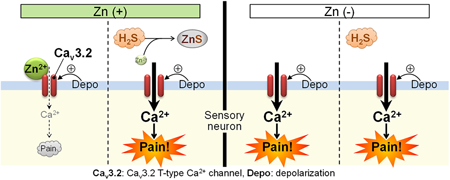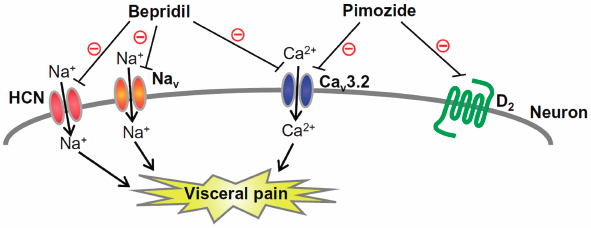- 著者
- Shiori Tomita Fumiko Sekiguchi Maho Tsubota Atsufumi Kawabata
- 出版者
- The Pharmaceutical Society of Japan
- 雑誌
- Biological and Pharmaceutical Bulletin (ISSN:09186158)
- 巻号頁・発行日
- vol.46, no.9, pp.1343-1346, 2023-09-01 (Released:2023-09-01)
- 参考文献数
- 22
- 被引用文献数
- 1
Cav3.2 channels belong to the T-type calcium channel (T-channel) family, i.e., low voltage-activated calcium channels, and are abundantly expressed in the nociceptors, playing a principal role in the development of pathological pain. The channel activity of Cav3.2 is suppressed by zinc under physiological conditions. We thus tested whether dietary zinc deficiency would cause Cav3.2-dependent nociceptive hypersensitivity in mice. In the mice fed with zinc deficient diet for 2 weeks, plasma zinc levels declined by more than half, and mechanical allodynia developed. The dietary zinc deficiency-induced allodynia was restored by T-channel inhibitors or by Cav3.2 gene silencing. These data demonstrate that zinc deficiency induces Cav3.2-dependent nociceptive hypersensitivity in mice, thereby suggesting that pain experienced by patients with diseases accompanied by zinc deficiency (e.g., chronic kidney disease) might involve the increased Cav3.2 activity.
- 著者
- Maho Tsubota Kazuki Matsui Saaya Fukushi Kyoko Okazaki Fumiko Sekiguchi Atsufumi Kawabata
- 出版者
- The Pharmaceutical Society of Japan
- 雑誌
- Biological and Pharmaceutical Bulletin (ISSN:09186158)
- 巻号頁・発行日
- vol.44, no.3, pp.461-464, 2021-03-01 (Released:2021-03-01)
- 参考文献数
- 23
- 被引用文献数
- 6
T-Type Ca2+ channels (T-channels), particularly Cav3.2, are now considered as therapeutic targets for treatment of intractable pain including visceral pain. Among existing medicines, bepridil, a multi-channel blocker, used for treatment of arrhythmia and angina, and pimozide, a dopamine D2 receptor antagonist, known as a typical antipsychotic, have potent T-channel blocking activity. We thus tested whether bepridil and pimozide could suppress visceral pain in mice. Colonic and bladder pain were induced by intracolonic administration of 2,4,6-trinitrobenzene sulfonic acid (TNBS) and systemic administration of cyclophosphamide (CPA), respectively. Referred hyperalgesia was assessed by von Frey test, and colonic hypersensitivity to distension by a volume load with intracolonic water injection and spontaneous bladder pain were evaluated by observing nociceptive behaviors in conscious mice. The mice exhibited referred hyperalgesia and colonic hypersensitivity to distension on day 6 after TNBS treatment. Systemic administration of bepridil at 10–20 mg/kg or pimozide at 0.1–0.5 mg/kg strongly reduced the referred hyperalgesia on the TNBS-induced referred hyperalgesia and colonic hypersensitivity to distension. CPA treatment caused bladder pain-like nociceptive behavior and referred hyperalgesia, which were reversed by bepridil at 10–20 mg/kg or pimozide at 0.5–1 mg/kg. Our data thus suggest that bepridil and pimozide, existing medicines capable of blocking T-channels, are useful for treatment of colonic and bladder pain, and serve as seeds for the development of new medicines for visceral pain treatment.

